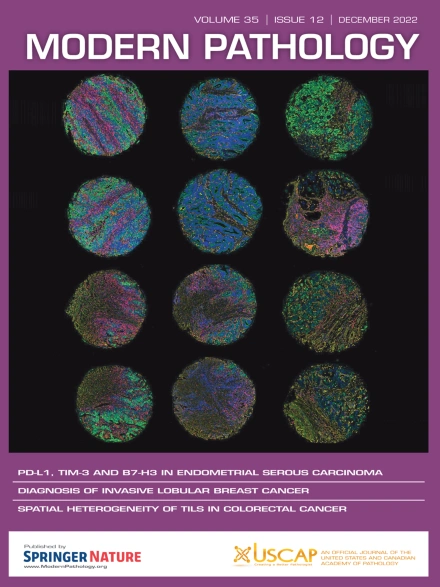纵向分析揭示了III期braf突变黑色素瘤患者接受新辅助治疗后组织病理学特征的动态变化
IF 5.5
1区 医学
Q1 PATHOLOGY
引用次数: 0
摘要
尽管在全身治疗方面取得了进展,皮肤黑色素瘤仍然是一种高度致命的疾病。高风险III期黑色素瘤患者手术后复发的可能性很大。虽然辅助免疫治疗一直是标准的治疗方法,但最近的证据表明,新辅助免疫治疗对高风险的III期患者更有效,与辅助免疫治疗相比,新辅助免疫治疗显示出更好的生存结果。这直接导致了临床实践向新辅助治疗的转变。NeoTrio临床试验评估了顺序或联合braf靶向治疗与抗程序性细胞死亡-1在新辅助环境中的疗效。然而,在这一治疗期间,对纵向组织病理学变化的研究仍然有限。对60名患者在4个匹配的新辅助治疗时间点的苏木精和伊红切片进行分析,揭示了许多治疗反应特征的动态变化。女性患者的主要病理反应率明显更高(P = 0.002),炎症性纤维化(P = 0.04)和透明性纤维化(P = 0.01)水平更高。三级淋巴结构(P = 0.013)和浆细胞(P = 0.02)在切除时的存在与疗效显著相关。组织病理特征的综合评分(综合评分和免疫相关病理反应[irPR]评分)与新辅助期早期的应答显著相关(治疗第2周的综合评分,P = .03;治疗第2周irPR评分较高,P = 0.01)。在治疗第2周,高irPR评分也被发现与早期新辅助时间点较低的复发率显著相关(P = 0.02)。与复发可能性较低相关的其他特征包括透明化纤维化增加(P = 0.015)、广泛淋巴细胞密度评分(P = 0.01)、三级淋巴样结构(P = 0.03)和浆细胞(P = 0.01)。本研究加深了我们对新辅助治疗过程中治疗反应标志物及其动态变化的认识。它强调了这些特征的重要性,特别是考虑到它们的早期出现和与反应和复发的强烈关联。本文章由计算机程序翻译,如有差异,请以英文原文为准。
Longitudinal Analysis Reveals Dynamic Changes in Histopathologic Features in Responders to Neoadjuvant Treatment in a Stage III BRAF-Mutant Melanoma Cohort
Despite advances in systemic therapies, cutaneous melanoma remains a highly deadly disease. Patients with high-risk stage III melanoma have a significant likelihood of recurrence following surgery. Although adjuvant immunotherapy has been the standard of care, recent evidence demonstrates that neoadjuvant immunotherapy is more effective for higher-risk stage III patients, showing superior survival outcomes compared with adjuvant immunotherapy. This has led to an immediate paradigm shift in clinical practice toward neoadjuvant therapy for this cohort. The NeoTrio clinical trial assessed the efficacy of sequential or combination BRAF-targeted therapy with anti–programmed cell death-1 in the neoadjuvant setting. However, research on longitudinal histopathologic changes during this treatment period remains limited. Analysis of hematoxylin and eosin slides from 60 patients across 4 matched neoadjuvant timepoints revealed dynamic changes in a number of treatment response features. Females achieved significantly higher rates of major pathologic response (P = .002) and displayed higher levels of inflammatory fibrosis (P = .04) and hyalinized fibrosis (P = .01). The presence of tertiary lymphoid structures (P = .013) and plasma cells (P = .02) at resection was significantly associated with response. Combination scoring of histopathologic features (composite score and the immune-related pathologic response [irPR] score) was significantly associated with response early during the neoadjuvant period (composite score at week 2 on-treatment, P = .03; high irPR score at week 2 on-treatment, P = .01). A high irPR score at week 2 on-treatment was also found to be significantly associated with a lower chance of recurrence at this early neoadjuvant timepoint (P = .02). Other features associated with a lower likelihood of recurrence included increased hyalinized fibrosis (P = .015) and the presence of extensive lymphocyte density score (P = .01), tertiary lymphoid structures (P = .03), and plasma cells (P = .01). This study deepens our understanding of treatment response markers and their dynamic changes during neoadjuvant therapy. It underscores the significance of these features, particularly given their early emergence and strong associations with response and recurrence.
求助全文
通过发布文献求助,成功后即可免费获取论文全文。
去求助
来源期刊

Modern Pathology
医学-病理学
CiteScore
14.30
自引率
2.70%
发文量
174
审稿时长
18 days
期刊介绍:
Modern Pathology, an international journal under the ownership of The United States & Canadian Academy of Pathology (USCAP), serves as an authoritative platform for publishing top-tier clinical and translational research studies in pathology.
Original manuscripts are the primary focus of Modern Pathology, complemented by impactful editorials, reviews, and practice guidelines covering all facets of precision diagnostics in human pathology. The journal's scope includes advancements in molecular diagnostics and genomic classifications of diseases, breakthroughs in immune-oncology, computational science, applied bioinformatics, and digital pathology.
 求助内容:
求助内容: 应助结果提醒方式:
应助结果提醒方式:


